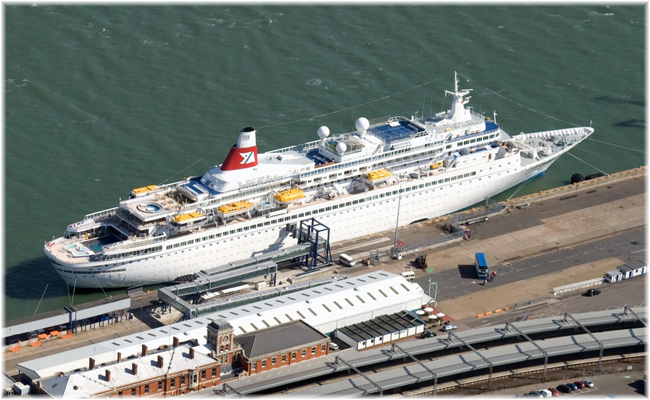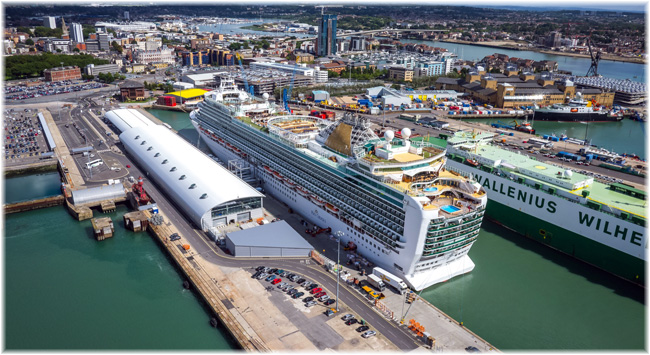More Ships For Fewer Than 1,000 Passengers – Other Cruise News: UK Cruise Market Misses Two Million – CMV Acquires Pacific Eden
 by Kevin Griffin
by Kevin Griffin
While recent news indicates that Viking Cruises’ ocean fleet may eventually number sixteen 930-berth ships, there is the possibility of four 700-berth ships being built for MSC Cruises, and four more 600-berth vessels for Fred. Olsen Cruise Lines. These would be in addition to the pair of 999-berth ships being built by Meyer Werft for Saga. The latest statistics for the UK cruise market revealed paltry growth last year, at 0.5%, for a total of 1,959,000 Brits taking a cruise. Germany surpassed two million cruisers in 2016. Finally, Cruise & Maritime Voyages has announced yet another acquisition, whose name will be announced tomorrow.
THIS WEEK’S STORY
More Ships For Fewer Than 1,000 Passengers
This month’s order by Viking Cruises for six more 930-berth ships from Fincantieri reminds us of news from other quarters that could see as many as four 600-berth ships built for Fred. Olsen Cruise Lines and four 700-berth ships for MSC Cruises.
With sixteen Viking ships and two 999-berth ships for Saga, this would come to twenty-six newbuildings. This does not include ultra-luxury vessels, although the final configuration of the MSC ships is not yet known.Various media have reported that Fred. Olsen Cruise Lines is planning a new series of 600-passenger exploration ships. Company chairman Fred. Olsen Jr recently confirmed he’d like to build a new ship to add to the line’s current fleet of four. The existing ships, Balmoral, Black Watch, Boudicca and Braemar, range from 800 to 1,350 berths.
Olsen added it would not make commercial sense to order just one purpose-built vessel and that more would follow, and this could be as many as four. Olsen said the company was talking to shipyards now, but he ruled out designing new ships for polar voyages.
A ship with around 600 berths would allow four restaurants, pubs, oriental tea rooms, observatory lounge and cabins with balconies as well as rigid inflatable boats (RIBs) and specialised tenders.
The present fleet of four ships will also be equipped with RIBs and some upper berths will be removed.
Olsen said he had decided on newbuildings rather than second-hand tonnage because ships now coming on the market were too big, at around 1,600 passengers. We have not reported on this plan so far as it still seems to be in the early stages and no shipyard has been named.
Early last month, we reported that the Italian-based Medi Telegraph had said that MSC Cruises was on the verge of ordering four ships for the luxury market from Fincantieri, who have much experience with this size of ship with the likes of the ultra-luxury lines Seaborn and Silversea.
While Fincantieri’s Italian yards may have full order books, they could be built by subsidiary Vard Holdings in Romania and/or Norway.
They would be smaller than any previous MSC orders, carrying only 700 passengers. No tonnage was reported but the ships are expected to be around 650 feet in length.
This would move MSC away from its present trend to building huge mega ships carrying thousands of passengers and open the line up to a new area of cruising, taking on cruise lines like Azamara Club Cruises, Oceania Cruises, Viking Cruises and possibly Crystal and Regent.
If both the MSC and Fred. Olsen plans reach fruition this would bring another eight ships into the market, the same number as the 684-berth “R” class ships built for the late Renaissance Cruises between 1998 and 2001. Four of these now work for Oceania, three for Azamara Club Cruises and one for Princess.
OTHER CRUISE NEWS
UK Cruise Market Misses Two Million
While Germany’s ocean cruiser count hit 2.19 million in 2017, an 8.4% increase on 2016, the UK, stretching hard to reach 2 million, has rather stagnated, with market growth of only 0.5%.
Between 2007 and 2017, the number of German ocean cruisers has almost tripled while the number of British cruisers has grown by only a third. Germany exceeded 2 million cruise passengers for the first time in 2016.
A record number of 1,959,000 Brits cruised in 2017, and an increasing number are travelling further afield, according to the Cruise Lines International Association (CLIA).
The fastest growth was in voyages to Northern Europe and exotic destinations such as Africa and the Middle East which saw an increase of almost a quarter. The biggest leap was in Canada and New England itineraries, which rose by a third.
The Mediterranean remains the most popular destination for UK passengers, representing 37% of all cruises booked last year, but it was Northern Europe that soared into second place with an increase of 8% to beat the Caribbean, which came third, with a rise of just over 3%.
In Germany, three out of four passengers cruised in Europe, with Northern Europe leading the way with a market share of 28%, ahead of the Mediterranean at 26%, the Caribbean at 11%, the Atlantic Islands at 9%, the Baltic at 7% and Africa and the Middle East at 5%. While Asia grew as a cruise destination for Germans it accounts for less than 3% of the German market.
In the UK, however, long-haul destinations saw a boom as Brits set sail for destinations including Africa and the Middle East, where bookings were up by nearly a quarter, Asia and China up by almost 22%, South America and the Panama Canal a rise of nearly 25% and Canada and New England, up 33%.

Caribbean Princess, the first Neo Panamax cruise ship to use the expanded Panama Canal in Agua Clara, near Colon (Click to enlarge)
Closer to home, cruises from UK ports rose to 1.1 million, up 6% year-on-year.
Germany also differs from the UK in that the average age of its cruisers is 49.6 years, compared to 56 for British cruise passengers.
CMV Acquires Pacific Eden
Cruise & Maritime Voyages Group has acquired the Pacific Eden from P&O Cruises Australia as a replacement for the much smaller Astor. The replacement ship will be more than double the size but will still offer a traditional cruise experience, along with the line’s Columbus, Magellan, Marco Polo and the chartered Astoria.

The Pacific Eden’s new name will be announced tomorrow, March 20, and the vessel will join CMV’s fleet in Singapore in early April 2019. She will be names for one of four explorers: Vasco da Gama, Pytheas, Henry Hudson and Amerigo Vespucci.
During a short period in dock, the livery will be changed and the ship will be re-branded before she makes her inaugural voyage to Northern Europe in 2019.
During the northern summer she will operate for CMV’s German arm TransOcean, sailing from Bremerhaven and Kiel, and during the Australian summer season, she will sail from Fremantle and Adelaide.
CMV’s UK, North American and other offices will also be marketing the voyages between Europe and the Antipodes and the wider Australian season.
The ship was launched in 1994 as Holland America Line’s Statendam. Her stay with P&O Australia will be less than three and a half years, althoguh she will be returning to Australia every year after her delivery to CMV.
(Kevin Griffin is managing director of specialist cruise agency The Cruise People Ltd in London, England. For further information concerning cruises mentioned in this article readers can visit his blog)








